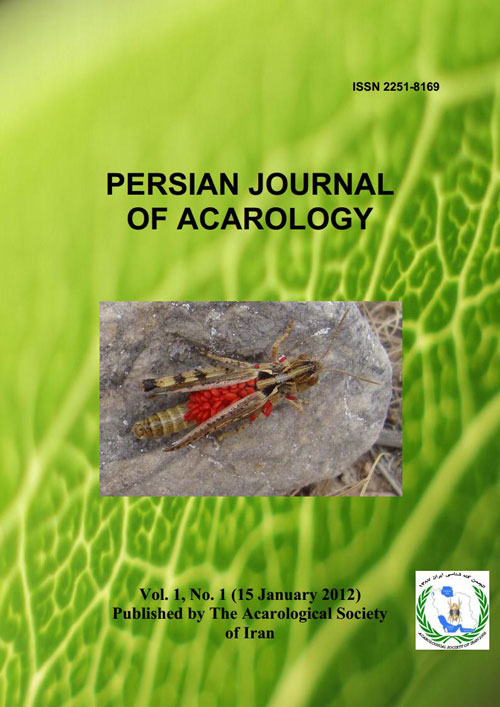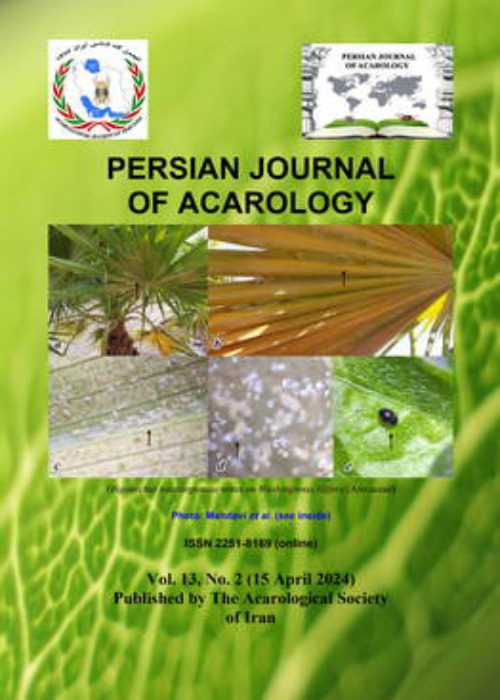فهرست مطالب

Persian Journal of Acarology
Volume:1 Issue: 1, Winter 2012
- تاریخ انتشار: 1391/04/30
- تعداد عناوین: 7
-
-
Page 1A new species of the sand-mite or chigger Schoengastia Oudemans, 1910 collected from the soil under camels thorn (Alhagi maurorum Medik) in Iran is described. The diagnosis of the new species is in conformity with the subgenus Priomesochela Vercammen-Grandjean et Langston, 1976, the specific characters are drip-dropping shaped sensilla, shortest scutal setae and least number in idiosomal setae in the subgenus.Keywords: sand mite, Schoengastia, Priomesochela, Trombiculidae, camel's thorn, new species, Iran
-
Page 11Allothrombium sicilianum sp. nov. (Acari: Prostigmata: Erythraeidae) is described from Sicily. It is the fourth known species of the genus Allothrombium with one seta on coxa II.Keywords: Acari, Trombidiidae, Allothrombium, new species, larva, Sicily
-
Page 17Oviposition rate is affected by several factors such as con- and heterospecific competitors, food availability and patch quality. When the species have interacted for a sufficient period of time, the predator could profit from the ability to associate odors from the competitor with the risk of its eggs being attacked or eaten by that competitor. We examined the oviposition rate of Phytoseiulus persimilis for a response for signals emanating from its heterospecific competitor, Frankliniella occidentalis in the presence of their shared prey, Tetranychus urticae on rose and bean leaf patches. In the treatments in which the predatory mite and thrips were exposed to each other, a significant reduction was observed in the number of deposited eggs compared to the control experiment. The same result was found in an experiment in which the exposure time was limited to the pre-oviposition period of the predatory mite. Increasing the time elapsed since the two competitors were exposed to each other to 2 days, the effect of thrips on the oviposition rate of the predatory mite had vanished and approached the oviposition rate in the control experiment. The plant species used as a substrate for the interspecific interactions did not significantly alter the results. We discuss the potential consequences of the presence of thrips for the ability of P. persimilis to control the two spotted spider mite.Keywords: Biological control, competition, oviposition, predatory mite, heterospecifics
-
Page 25A new water mite, Hydrodroma persica sp. nov. (Hydrodromidae), is described from running waters inSouthern Iran.Keywords: Acari, water mites, new species, taxonomy, running waters
-
Page 33Charletonia shahriari sp. nov. is described and illustrated from larvae ecto-parasitic on undetermined cercopids (Hemiptera: Cercopidae) in a wheat field in Tabriz city, East Azarbaijan province, Iran. It is the second species of this genus with two setae between coxae II and III and solenidion placed in proximal half of genu I.Keywords: Trombidiformes, Charletonia shahriari sp. nov., larva, ectoparasite, Cercopidae, Iran
-
Page 42Two new species: Hauptmannia dagmarae sp. nov. and Lassenia castronuoviensis sp. nov. from Italy are described and illustrated. Hauptmannia kotorensis, Leptus (Leptus) hammameticus, Erythraeus (Zaracarus) preciosus and Valgothrombium valgum are reported for the first time from Italy.Keywords: Acari, Erythraeidae, Microtrombidiidae, Tanaupodidae, new species, new records, Italy
-
Page 53A new species of oribatid mite of the family Oppiidae, Ramusella (Ramusella) iranica sp. nov., is described from Iran. The new species is characterized by the radiate sensillus, with ten long ciliae on its head; barbed notogastral setae and five pairs of genital setae. An identification key to the Iranian species of Ramusella (Ramusella) is given.Keywords: Oribatida, Oppiidae, Ramusella, new species, Iran


